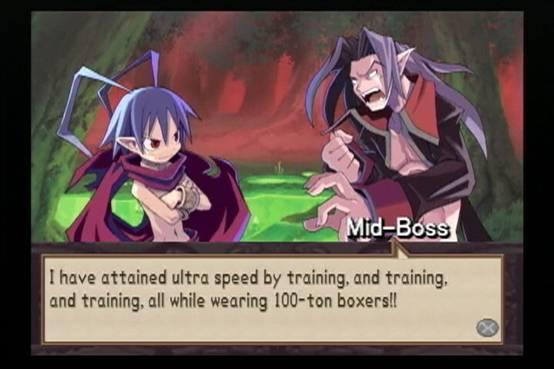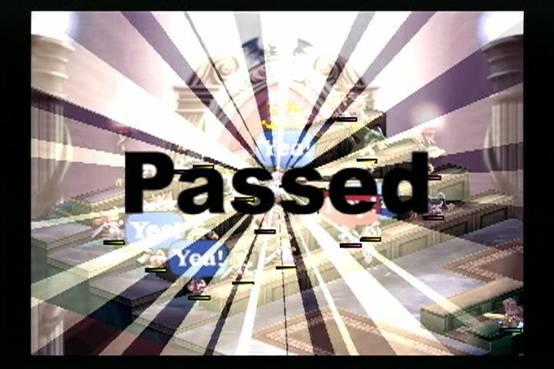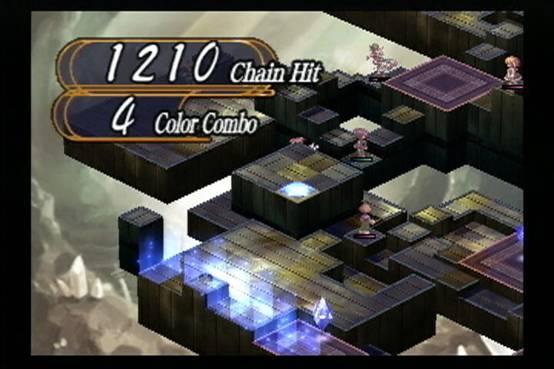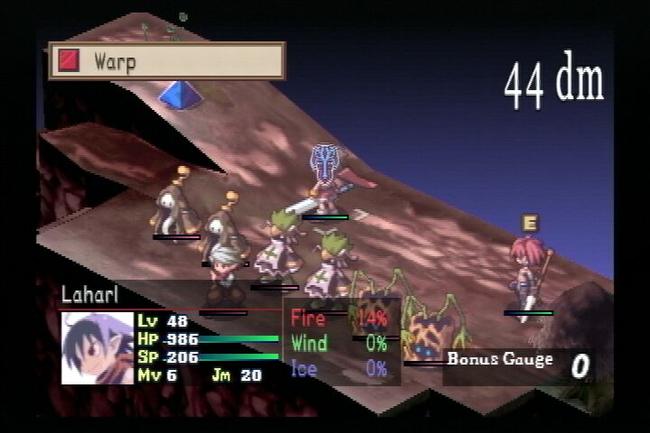
Disgaea: Hour of Darkness Review
Before this game dropped on my doorstep, I had never, ever heard of Nippon Ichi. Shame on me, working on an RPG Site and never hearing of such a company as NI, but truthfully, I slotted this disk into my PS2 with little or no expectation at all. As the game loaded up, and the gentle opening music kicked in (sounding like it was coming from an old fashioned music box), I wondered just what exactly I had let myself in for.
Disgaea: Hour of Darkness tells the story of a young prince, Laharl. (By young, I mean 1400 years old – but that’s young for a demon) Laharl awakes from a two-year nap to find that his father, the Overlord of the Netherworld is dead, and the Netherworld is in civil war as demons fight one another for dominance. Laharl, being a spoilt, egotistical little demon, decides the Netherworld is his and his alone, and sets out to take control of his father’s legacy once more.
An insanely simple plot, I hear you all cry; and it is. This is the point where in a review of a game of this type I’d expect to say “but the plot doesn’t matter that much because…”, but I’m not. The plot in this game is an absolute masterpiece; and the execution is fantastic. The antics of egotistical Laharl as his band of vassals follow his orders as he attempts to live up to his name are not only engaging, but funny too.
The plot is told through scenes of the like that has not been seen since 8 and 16-bit games. A series of character portraits which show the character’s emotion in a very basic way and text boxes accompany some of the most excellent voice acting I have heard in a game ever. You can see just how it’s laid out below. Though, like the plot it tells, it is basic, it works amazingly. The plot sucks you in with its constant quirky humor and deep characters, the game drew me in instantly and made me really care about what was going on in-game. There is a certain charm to the story and the way it is told which is just not present in many games.

The way the story is presented throughout is an utter triumph, and shows not everything needs to be CG-with-all-the-trimmings in this new 3D age. The game never ever really takes itself too seriously, which is hugely refreshing for a regular RPG player – as many RPGs follow an all too serious Life and Death plotline. Only in Disgaea can you find a main character that is afraid of women “Get your sexy body away from me!”, or an all-powerful item that gives you double strength, called… Horse Weiner. A slightly slow start sees the story rocket into action from the third chapter onwards, at a pace that never really slows or stops right up until the end.
Similarly to the way in which the plot is shown, the graphics in the game remain minimalist. Nippon Ichi, apparently, are famed for this type of Graphic – 2D sprites, not unlike what you would see in the days of the SNES on 3D backgrounds. It really does work quite well, and it all adds to the whole atmosphere of the game that makes it feel so light hearted and fun. Thanks to the fact the PS2 is of course many, many times over more powerful than the SNES, and with much more storage capacity on its disks, the sprites are of a very high quality and so also look great on screen, even next to the 3D backgrounds. In this sense, especially since hundreds of characters are available, the artistry that has gone into the art direction of Disgaea is really evident.
Just because it is artistic, however, does not mean it is necessarily all that good. The animation is in many places jerky, and better animation has been seen in games for a long time now, going a generation back from this title. While the characters look good, and are detailed in comparison to classic sprites in the days of carts, the detail on the characters is nothing compared to the standard we have come to expect from a Playstation 2 title today. The basic camera angles offered (part of the limitation, I’d say is down to use of sprites) sometimes means the most spectacular of special moves or spells are redundant to your eyes, because you can’t see past the huge cliff on the map to watch Laharl or Etna perform it.
The spells and combo animations are also equally as basic. I’m not saying that it’s all particularly bad – as I said, it’s all integral to the game’s charm and look; and the spells and moves do look awesome on-screen. But technologically, this game has not pushed the envelope or even reached the point an ‘average’ title does these days. To sum the Graphics up; they may not be pretty, but they’re appealing.
The gameplay in Disgaea is made up of two parts: At the Castle, and on the Battlefield. This isn’t like a regular RPG, with a world map and so on. You end up going straight from the Castle to the Battlefield and back again. The castle works pretty much like a town in any RPG game. You can buy, sell and equip items, heal, create new characters, interact with other characters, and so on and so forth. In a way it is better than going from town to town; you get to know the characters in the castle, and on some missions they even aid you.
Like most of the Gameplay elements in Disgaea, it is a more complex version of RPG clichés – for example, to stop you buying Powerful items early on, the two stores level up as you do – offering higher quality items with each level up. Incidentally, I have to make note that some of the items and item descriptions in this game are absolutely hilarious.
Aside from to the different things in the castle, you can also head to the “Item World” and the “Dark Assembly”. The Dark Assembly is where you create new characters. It is like a congress of demons, and Laharl must go through them to change things in the world. Proposals could be anything, from you wanting to create a new Mage or Solider for your team, right down to extorting military funds from the assembly, unlocking new worlds, or making more valuable items available in the shop.

Some are easier to pass than others; for example, senators will not care if you want to create a new character, but when you try to take military funds from them, they’re bound to say no. There’s a number of ways to persuade the senators to your cause, including bribing them by giving them rare items, or by simply choosing to fight them and beat them into submission when you are powerful enough later on.
Your respect with the senators will also increase as you become more powerful, and for every monster you kill. How far you go into the Dark Assembly really has an effect on how complex the game gets. The interesting thing is every individual character in your team has respect with the senators on a different level – so if one character can’t pass a bill, another may.
Character creation in Disgaea gives you a whopping 120 classes of character to play with, providing you unlock them all. Some Monsters, some Humanoid Demons, every class has a list of Strengths, Weaknesses and Attributes as you’d expect from any RPG. There is a system known as the “Mentor/Pupil” relationship, which basically means two characters are connected. If I go into the Dark Assembly with Laharl and create a character called Alex, that character will be Laharl’s pupil, and Laharl will be his mentor.
These characters have a link, and as one grows, so does the other. They can also do special combo attacks on the battlefield. If your character reaches the top of their class, you can then “Transmigrate” the character, returning them to Level 1, but as a different class, keeping some of their stats and abilities from the previous class. This process can be repeated hundreds of times over to create the ultimate character. After all, some classes will have to get all the way to the maximum level of 10,000 to be worth transmigrating.

The Item World is a system where you can level up an item to make it more powerful. Inside every item are monsters. You must go inside the item and subdue the monsters to level the item up. But for that, you need the second half of Disgaea: Combat.
As you may have noticed, this game is already starting to bear a striking resemblance to Final Fantasy Tactics and Ogre Battle but more complex; and that’s precisely what it is! Disgaea can seem overwhelming hearing it and looking at screens, but the game can actually be completed with minimal knowledge.
Battles take place on an isometric 3D battlefield, with grids covering it. Your characters move around on the grids, as do the enemy, and you attack each other. The system is turn based where the player moves their characters, then the enemy, then the players. Simple enough, right?
Not quite. The enemy AI is very, very intelligent and depending on the level and the moves you can make, the game can turn into a real tactical nightmare. One thing that greatly effects the terrain is “Geo Symbols”. These are basically coloured panels that effect parts of a battlefield, and they have an effect on whatever character is standing on them. Some Geo Symbols are positive, offering things like “Defence +50%” or “Atk +25%”, while others can well and truly screw you over, taking away half your HP if you stand on them for a turn.
Thanks to an in-game tutorial, you learn how to use Geo Symbols to combo each other, and you can destroy all the geo symbols on the map, or selectively destroy a few of them. The system is very cleverly thought out, and adds a whole new spin to the age old isometric SRPG battle system. Huge combos can be gained by destroying Geo Symbols – the highest I’ve ever got is just over 6400. These combos can not only help you, but kill the enemy, and, if you mess up, help them.

Now you see, aside from the lack of any impressive graphics, Disgaea has one, major problem. It is god damned hard. Speaking of Combos from Geo Symbols, you can also get Combos with characters. Characters with a relationship that attack the same enemy will perform a combo attack with the two of them inflicting more damage.
The Battlefield is also home to the single most annoying and buggy aspect of the game – the camera. In the Castle, the Camera is not an issue, however, in battle, where the camera sometimes dynamically moves around in the more extravagant spells and moves, your view can get totally obstructed by the hills on the terrain. On occasion, this can make battle difficult, but it’s not such a frequent problem to make the game or battles unplayable.

The controls throughout the game are tight and solid – being an RPG and mostly menu based they don’t need to be amazing. They are, on occasion, a little bid fiddly.
The soundtrack of this game is nothing short of excellent. As is expected from Japanese-made RPGs, a variety of sounds inspired by a variety of different genres of music punctuate your gameplay. The music always follows the onscreen action and never feels out of place. The soundtrack avoids using an orchestra for a dramatic sound, instead having a soundtrack equally as quirky as the game. As mentioned earlier, the voice acting is of an extremely high quality throughout. Like the rest of the game, it mocks itself, being deliberately sarcastic and cheesy throughout.
Despite all the information in this huge review, there’s still much of Disgaea to tell you about. Past the thirteen chapters of the story mode, you can keep playing and playing. I’ve poured almost 150 hours into the game in my 2 years of owning it, and it’s still enjoyable, with nothing at all repetitive.
And that’s the special thing about Disgaea: Hour of Darkness that makes it worth owning. It never gets boring. No matter how long you play it for, or how much complexity you take from the game – be it right down to the deepest levels, or just scratch the surface, barely going into the Dark Assembly, you will still enjoy it for its originality, funniness, freshness, and huge cast of hilarious and brilliant characters. It’s unlikely to appeal to casual gamers. But this is a site for RPG fans, so to you guys I say: Pick this up. It's fantastic.